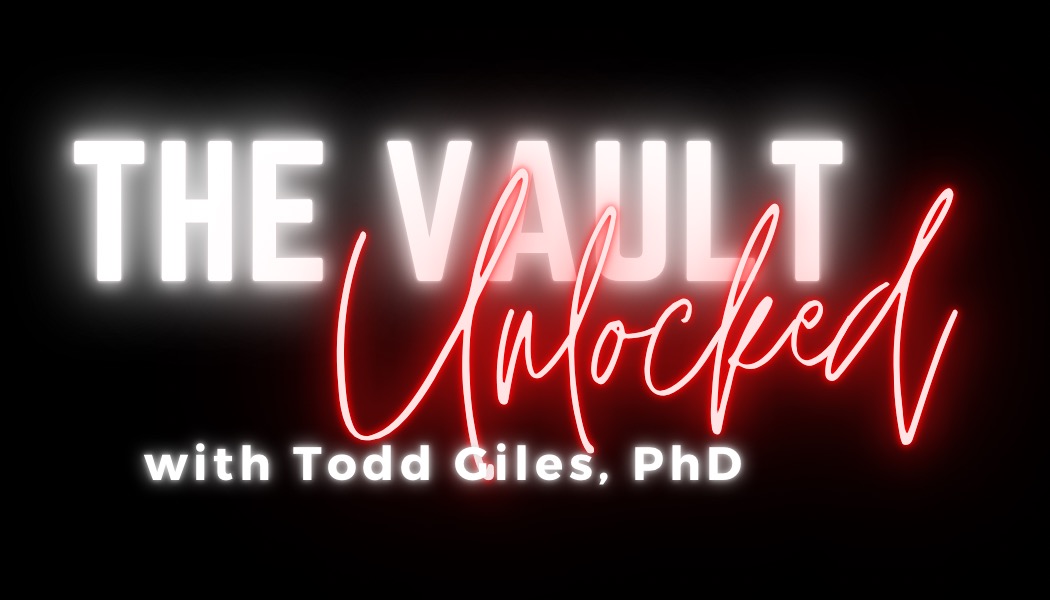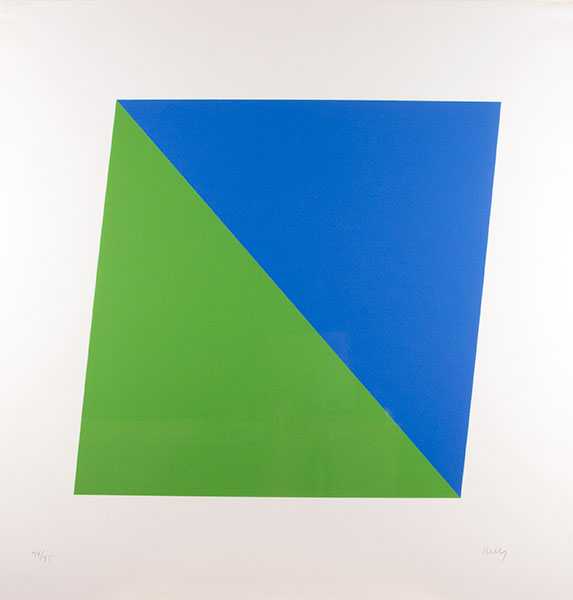
Ever wonder where the art is stored at the WFMA, and what's in there anyway? Join MSU professor Todd Giles as he unlocks the vault!

Ellsworth Kelly
Blue/Green, 1970
One of Series of Ten Lithographs
39 1/2" x 37 3/4”
Signed & numbered in pencil 74/75
Special Arjomari paper
Printed & published at Gemini G.E.L., Los Angeles
Museum purchase, 1972
“Above all else Kelly’s art is about the declaration of a precise, simplified form, either alone or in interaction with others.”
~ Richard Axsom
[Transcript]
Hello and welcome to The Vault Unlocked. My name is Todd Giles and we’re here to take you inside the collection vault at the Wichita Falls Museum of Art at MSU Texas because getting to know art helps us better know ourselves. In this episode, we will take a close look at Ellsworth Kelly’s 1970 lithograph titled Blue/Green from his Series of Ten Lithographs.
Ellsworth Kelly’s (1923–2015) service in the US Army during the Second World War found him stationed in the French countryside a few miles outside of Paris, just close enough to immerse himself in the capital city’s art scene as best one can during wartime. Another early influence on Kelly’s future aesthetics came from developing and deploying camouflage for his battalion, which taught him about the use of shadows, forms, and the visible and invisible. Kelly served with other artists in what was known as The Ghost Army, a subterfuge unit that employed inflatable tanks and other seemingly largescale equipment to cloud the Axis’ understanding about Allied troop sizes and movements.
After his service ended (much like Ernest Hemingway and many other American modernist writers and artists after the previous war), Kelly decided to return to Paris in 1948 to study at the Ecole des Beaux-Arts, where he stayed until 1954. While in Paris, Kelly came under the influence of the work of Picasso, Matisse, and Mondrian, as well as the earlier architectural styles of the Romanesque and Byzantine periods. According to art historian Elizabeth Kornhauser, Kelly was also heavily influenced by several members of the School of Paris who he had occasion to befriend, including Jean Arp, Constantin Brancusi, and Alexander Calder. From these older artists, he was “introduced to geometric and biomorphic abstraction and Surrealism, and began to experiment with these styles in his own work” (199). Upon his return home to New York in 1954—his style already firmly established outside of the weighty influence of the American abstract avant-garde—he became friends with Pop artists Robert Indiana and James Rosenquist, both of whom are also represented in the WFMA’s permanent collection.
Kelly turned to printmaking as a serious art form while on two return visits to Paris in the mid-1960s. 1970 saw the beginning of his long collaboration with the Gemini G.E.L. studio in Los Angeles. Gemini was one of the most important printmaking studios in America during the post-war period, alongside Tamarind Lithography Workshop (also in LA), Stanley Hayter’s Atelier 17 in New York City, and Universal Limited Art Editions in Long Island, NY. Other artists in the WFMA’s permanent collection who worked at Gemini include Ron Adams, Robert Rauschenberg, Claes Oldenburg, Frank Stella, and Tom Wesselmann, to name a few. Kelly collaborated with Kenneth Tyler at Gemini, whose choice of a special smooth paper from France known as Arjomari enabled Kelly to create his flat, hard-edged expanses of color, because with Arjomari the ink stays on the surface rather than being absorbed into the fibers of the paper.
The entirety of Kelly’s 1970 Series of Ten Lithographs, including Blue/Green seen here, bring together at least two sharp colors in either off-kilter squares (some seen straight on, others three-dimensionally), individual or vertically-stacked skinny rectangles (also cockeyed), and one unequally-divided vertical rectangle. Other titles in the series include, for example, Red-Orange/Yellow/Blue, Black/White/Black, and Orange/Green. Ten Lithographs differs markedly from the two earlier series Kelly produced in Paris in that he left behind his more organic, curvilinear shapes for these hard, angular, geometric forms.
All of the prints in this series are drawn from Kelly’s earlier paintings and sculptures produced between 1967 and 1970. Blue/Green joins two sharply delineated isosceles triangles in vivid tones. The piece is a translation into the print medium of Kelly’s 1968 painted aluminum sculpture titled Green/Blue, which is housed at the Modern Museum or Art in New York. This concept of “recycling” one’s earlier works is not unique to Kelly; for other examples from the post-war period in the WFMA’s permanent collection, see Lee Krasner’s Embrace (1974), Jasper John’s Fool’s House (1972), and Jackson Pollock’s Untitled (1951).
While his artworks might at first glance appear to fly in the face of what we expect and desire from art (i.e. representation, symbolism, story, etc.), Kelly’s post-painterly abstractions are really quite subjective in that they stem from his personal observations of the real world. According to Ellsworth Kelly scholar Richard Axsom,"Kelly’s art is based upon perception. He appropriates fragments of chanced-upon visual experience—bits of architecture, the human figure, water reflections, shadows—and abstracts them into taut, iconic images of broadly articulated shape and saturated color, lyrical and serenely self-confident in effect. His art is an act of distillation from the seen; its sources are rooted not in the mind, but in nature. (13)".
Kelly’s gaze was drawn to the interplay of light, space, color and shadow. In a way, you might say his philosophical and aesthetic emphasis was more akin to that of the French Impressionists than it was to the acts of dynamism and spontaneity of the Abstract Expressionists or the cultural critiques of his Pop art colleagues. One thing is for sure: Kelly did play an important role in influencing abstract artists working in the realms of Pop, Minimalism, and Color Field painting in mid-century America. His inspiration was the in-between places, the traces, the elements left unseen.
Thanks for joining us as we unlock the vault at the Wichita Falls Museum of Art at MSU Texas. To learn more about the WFMA our current and upcoming exhibitions, the permanent collection, as well as sign up for our e-newsletter, visit wfma.msutexas.edu.
Works Consulted
Axsom, Richard H. The Prints of Ellsworth Kelly: A Catalogue Raisonné 1949-1985. Hudson Hills Press, 1987.
Castleman, Riva. Prints of the Twentieth Century: A History. New York: Museum of Modern Art, 1976.
Kornhauser, Elizabeth Mankin. American Moderns on Paper: Masterworks from the Wadsworth Athenaeum Museum of Art. Yale UP, 2010
Blue/Green from the Permanent Collection of the Wichita Falls Museum of Art at MSU Texas
View Previous The Vault Unlocked
-
Tuesday - Friday
10:00AM - 5:00PMSaturday
1:00PM - 5:00PM